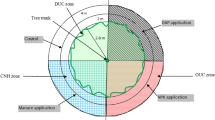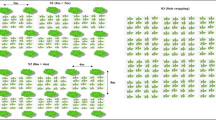Abstract
Bamboo-based agroforestry is a promising option for sustainable land management in India. Optimal management of bamboo-based mixed species production systems, however, requires an understanding of bamboo spacing, root activity and distribution of bamboo roots, and the soil nutrient capital of the site. We examined the performance of turmeric as an understorey crop in 7-year old bamboo (Dendrocalamus strictus (Roxb.) Nees) stands of varying spacing treatments (4 × 4, 6 × 6, 8 × 8, 10 × 10 and 12 × 12 m) at Kerala Agricultural University Campus, Thrissur, Kerala, India. In order to better understand turmeric and bamboo growth parameters, soil physico-chemical properties, understorey light availability and turmeric root activity by soil injection of 32P were determined in mixed (turmeric + bamboo) and sole turmeric situations. To characterize root activity, 32P was applied at 10 cm depth to the turmeric plants in raised beds established between the two central rows of bamboo in all experimental plots. Growth attributes of bamboo were recorded and the soil was analyzed for physico-chemical properties before intercropping. Results revealed that spacing treatments exerted profound influence on bamboo growth. For instance, clump height decreased by 19 % in the widest (12 × 12 m) bamboo spacing compared to that of the closest (4 × 4 m) spacing. However, widely spaced bamboo exhibited better clump diameter, crown coverage and turmeric rhizome yield, whereas, closest (4 × 4 m) spacing of bamboo plot recorded least rhizome yield of 8 Mg/ha; this was 58 % less compared to widest spacing of 12 × 12 m (19.32 Mg/ha). Soil N, P and K at widest spacing was 56, 45 and 33 % less compared to that of the closest spacing. NPK uptake by turmeric also increased in the wider spacing treatments. Factors contributing to reduction in growth of turmeric in the denser bamboo stands may be the high LAI (6.77 in 4 × 4 m spacing) as compared to widest spacing (0.44 in 12 × 12 m spacing) of bamboo, low understorey PAR (107 µmol/sec/m2) and high root competition. Due to competition by bamboo, 89 % decline in 32P absorption by turmeric at closest spacing of bamboo was observed compared to the bamboo-less plot. On a final note, turmeric, although a shade tolerant Zingiberaceae crop, may perform better if light transmittance is between 66 and 86 % and for optimal performance of the understorey turmeric in mixed species systems, wider bamboo spacings beyond 8 × 8 m are recommended.








Similar content being viewed by others
References
Babu P, Jayachandran BK (1994) The quality of ginger (Zingiber officinale) as influenced by shade and mulch. South Ind Hortic 42(3):215–218
Banerjee H, Dhara PK, Mazumdar D (2009) Bamboo (Bambusa sp.) based agroforestry systems under rainfed upland ecosystem. J Crop Weed 5(1):288–292
Bhol N, Nayak H (2014) Spatial distribution of root and crop yield in a bamboo based agroforestry system. Ind For 140(6):135–139
Christanty L, Kimmins JP, Mailly D (1997) “Without bamboo, the land dies”: A conceptual model of the biogeochemical role of bamboo in an Indonesian agroforestry system. For Ecol Manag 91:83–91
Divakara BN, Kumar BM, Balachandran PV, Kamalam NV (2001) Bamboo hedgerow systems in Kerala, India: Root distribution and competition with trees for phosphorus. Agrofor Syst 51:189–200
Faget M, Nagel KA, Walter A, Herrera JM, Jahnke S, Schurr U, Temperton VM (2012) Root–root interactions: extending our perspective to be more inclusive of the range of theories in ecology and agriculture using in vivo analyses. Ann Bot 112:253–256
FAO (2002) Ginger: Post-production management for improved market access, Post-harvest compendium, Food and Agricultural Organisation, p 22
Gao L, Xu H, Mail BH, Xi W, Bao B, Wang X, Bi C, Chang Y (2013) Intercropping competition between apple trees and crops in agroforestry systems on the Loess Plateau of China. PLoS One 8(7):707–739
George SJ, Kumar BM, Wahid PA, Kamalam NV (1996) Root competition for phosphorus between the tree and herbaceous components of silvopastoral systems in Kerala. Plant Soil 179(2):189–196
Giardina CP, Ryan MG (2002) Total belowground carbon allocation in a fast growing eucalyptus plantation estimated using a carbon balance approach. Ecosystems 5:487–499
Gower ST, Kucharik CJ, Norman JM (1999) Direct and indirect estimation of leaf area index, f(APAR), and net primary production of terrestrial ecosystems. Remote Sens Environ 70:29–51
Hummel S (2000) Height, diameter and crown dimensions of Cordia alliodora associated with tree density. For Ecol Manag 127:31–40
IAEA (1975) Root activity patterns of some tree crops. Int At Energy Agency, Vienna
Jackson ML (1958) Soil chemical analysis. Asia Publishing House, New Delhi, p 498
Jaiswal CS, Mishra VK, Verma KS (1993) Intercropping ginger and turmeric with poplar (Populus deltoides ‘G-3’ Marsh). Agrofor Syst 22:111–117
Jha LK, Lalnuntluanga F, Marak CH (2004) Study on the growth performance of bamboo species Melocanna baccifera and Dendrocalamus longispathus along with crop (Glycine max) in degraded jhum land of Mizoram. Ind For 130(9):1071–1077
John CK, Nadagouda RS (1995) Bamboos: cradle to bier companions. Sci Rep, 16–19
Jolly WM, Nemani R, Running SW (2004) Enhancement of understory productivity by asynchronous phenology with overstory competitors in a temperate deciduous forest. Tree Physiol 24:1069–1071
KAU (2011) Package of practices recommendations: crops, 14th edn. Kerala Agricultural University, Thrissur, p 360
Kibwage JK, Netondo GW, Odondo AJ, Oindo BO, Momanyi GM, Jinhe F (2008) Growth performance of bamboo in tobacco-growing regions in South Nyanza. Kenya. Afr J Agric Res 3(10):716–724
Kirtikar KR, Basu BD (1988) Indian medicinal plants, vol II. India Book Distributors, Dehra Dun, pp 2444–2449
Kleinhenz V, Midmore DJ (2001) Aspects of bamboo agronomy. Adv Agron 74:99–153
Koenig R, Johnson C (1942) Colorimetric determination of phosphorus in biological materials. Ind Eng Chem Anal Ed 14(2):155–156
Kumar BM (1997) Bamboos in the homegardens of Kerala: a shrinking resource base. J Non-timber For Prod 4(3/4):156–159
Kumar BM (2008) Litter dynamics in plantation and agroforestry systems of the tropics—a review of observations and methods. In: Batish DR, Kohli RK, Jose S, Singh HP (eds) Ecological basis of agroforestry. CRC Press, Boca Raton, pp 181–216
Kumar BM, Divakara BN (2001) Proximity, clump size and root distribution pattern in bamboo: a case study of Bambusa arundinacea (Retz.) Willd., Poaceae, in the Ultisols of Kerala India. J Bamboo Rattan 1(1):43–58
Kumar BM, Thomas J, Fisher RF (2001) Ailanthus triphysa at different density and fertilizer levels in Kerala, India: tree growth, light transmittance and understorey ginger productivity. Agrofor Syst 52:133–144
Kumar BM, Kumar SS, Fisher RF (2005) Galangal growth and productivity related to light transmission in single-strata, multistrata and no-over-conopy systems. J New Seeds 7(2):111–126
Kunhamu TK, Kumar BM, Viswanath S, Sureshkumar P (2008) Thinning promotes understorey ginger productivity in Acacia mangium willd. Stands of Kerala, India. In: Yahya AZ, Ngah MI, Ariff FF, Rahman ZA, Abdulla MZ, Philip E, Chik SW (eds.) Proceedings of the international agroforestry conference Kuala Lumpur, Malaysia, Transactions of the Malaysian Society of Plant Physiology, vol 15. pp 47–60
Kunhamu TK, Kumar BM, Samuel S (2011) Does tree management affect biomass and soil carbon stocks of Acacia mangium wild. stands in Kerala, India? In: Kumar BM, Nair PKR (eds.) Carbon sequestration potential of agroforestry systems, opportunities and challenges, Advances in Agroforestry, vol 8. Springer, Dordrecht, pp 217–228
Lehmann J, Schroth G (2003) Nutrient leaching. In: Schroth G, Sinclair FL (eds) Trees, crops and soil fertility. CABI Publishing, Wallingford, pp 151–166
Lehmann J, Muraoka T, Zech W (2001) Root activity patterns in an Amazonian agroforest with fruit trees determined by 32P, 33P and 15N applications. Agrofor Syst 52:185–197
Long SP, Zhu GX, Naidu SL, Ort DR (2006) Can improvement in photosynthesis increase crop yields? Plant, Cell Environ 29:315–330
Nair GS, Sudhadevi PK, Kurian A (1991) Introduction of medicinal and aromatic plants as intercrops in coconut plantations. In: Raychaudhuri SP (ed) Recent advances in medicinal, aromatic and spice crops, vol 1. Today and Tomorrow’s Printers & Publishers, New Delhi, pp 163–165
Nath AN, Das AK (2008) Bamboo resources in the homegardens of Assam: a case study from Barak Valley. J Trop Agric 46(1–2):58–61
Piper CS (1967) Soil and plant analysis. Asia Publishing House, Bombay, pp 130–138
Postma JA, Dathe A, Lynch JP (2014) The optimal lateral root branching density for maize depends on nitrogen and phosphorus availability. Plant Physiol 166:590–602
Rowe EC, van Nordwijk M, Suprayog D, Hairiah K, Giler KE, Cadisch G (2001) Root distributions partially explain 15N uptake patterns in Gliricidia and Peltophorum hedgerow intercropping systems. Plant Soil 235:167–179
Santantonio Dan (1990) Modeling growth and production of tree roots. Process modeling of forest growth responses to environmental stress. Timber Press, Portland, pp 124–141
Schmidt WC, Shearer RC, Roe AL (1976) Ecology and silviculture of western larch forests. Tech. Bull. 1520. USDA Forest Service, Washington DC
Seidel KW (1984) A western larch-engelmann spruce spacing study in eastern Oregon: results after 10 years. Res. Note PNW-RN-409. Portland, OR: U.S. Department of Agriculture, Forest Service, Pacific Northwest Research Station. p 5
Singh KA (2000) Litterfall and changes in the soil properties as influenced by age and tree density in Alnus nepalensis D. Don Indian J Agrofor 2:37–42
Sinha A, Nath S (2007) Prospects of tissue culture raised exotic bamboo (Dendrocalamus asper) in eastern India. In: Proceedings of the national conference on increasing forest productivity: genetic and breeding options, TFRI, Jabalpur, 21–23 Feb 2007
Sjolte-Jorgensen J (1967) The influence of spacing on the growth and development of coniferous plantations. Int Rev For Res 2:43–94
Smith J (2010) Agroforestry: reconciling production with protection of the environment. Organic Research Centre, Elm Farm, Hamstead Marshall, Newbury, p 24
Stenberg P, Linder S, Smolander H, Flower-Ellis J (1994) Performance of the LAI-2000 plant canopy analyzer in estimating leaf area index of some Scots pine stands. Tree Phys 14:981–995
Taugourdeaua S, le Mairea G, Avelino J, Jonese JR (2014) Leaf area index as an indicator of ecosystem services and management practices: an application for coffee agroforestry. Agric Ecosyst Environ 192:19–37
Thomas J, Kumar BM, Wahid PA, Kamalam NV, Fisher RF (1998) Root competition for phosphorus between ginger and Ailanthus triphysa in Kerala, India. Agrofor Syst 41:293–305
Tripathi SK, Singh KP (1994) Productivity and nutrient cycling in recently harvested and mature bamboo savannas in the dry tropics. J Appl Ecol 31:109–124
Wahid PA, Kamalam NV, Sankar SJ (1985) Determination of 32P of wet digested plant leaves by Cerenkov counting. Int J Appl Rad Isot 36:323–324
Wahid PA, Kamalam NV, Sankar SJ (1988) A device for soil injection of 32P solution in root activity studies of tree crops. J Plant Crops 16:62–64
Watanabe FS, Olsen SR (1965) Test of an ascorbic acid method for determining phosphorus in water and NaHCO3 extracts from soil. Soil Sci Soc Am Proc 29:677–678
Wythers KR, Reich PB, Turner DP (2003) Predicting leaf area index from scaling principles: corroboration and consequences. Tree Physiol 23:1171–1179
Zhang P (1999) Nutrient inputs from trees via throughfall, stemflow and litterfall in an intercropping system. MSc Thesis submitted to the University of Guelph, Canada, p 50
Acknowledgments
This work forms part of the PhD dissertation project of the first author. The bamboo spacing trial was established using an AP Cess fund research Grant from the Indian Council of Agricultural Research, New Delhi to B. Mohan Kumar (2004–2007). The authors thank Dr. Asha K Raj and Dr. AV Santosh Kumar for the help in analyzing the data. We also thank Dr. PS John for valuable comments and suggestions during crop measurements and nutrient analysis. The financial assistance provided to the first author by the Kerala Agricultural University for undertaking this research project is gratefully acknowledged.
Author information
Authors and Affiliations
Corresponding author
Rights and permissions
About this article
Cite this article
Kittur, B.H., Sudhakara, K., Mohan Kumar, B. et al. Bamboo based agroforestry systems in Kerala, India: performance of turmeric (Curcuma longa L.) in the subcanopy of differentially spaced seven year-old bamboo stand. Agroforest Syst 90, 237–250 (2016). https://doi.org/10.1007/s10457-015-9849-z
Received:
Accepted:
Published:
Issue Date:
DOI: https://doi.org/10.1007/s10457-015-9849-z




